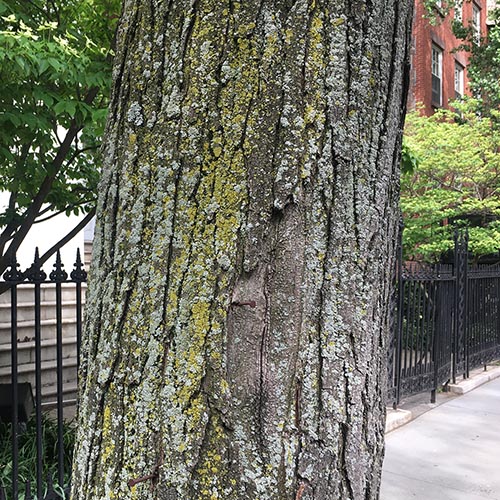
Listen to this Episode:
- From this webpage:
- Find the media player located under the episode picture.
- Click on the green triangle to listen to the audio for this episode.
- From your favorite podcast listening platform:
- Search for “Backyard Ecology.”
Show notes:
Lichens are AMAZING organisms. You can find them practically everywhere from very urban areas to very rural areas. You can find them growing on trees, rocks, buildings, benches, and all kinds of different things. But many of us really don’t know a whole lot about lichens.
In today’s episode of the Backyard Ecology podcast, I talk with Dr. James Lendemer. James is the lichenologist at the New York Botantical Gardens and a professor at the City University of New York. He also co-authored the book, Urban Lichens: A Field Guide for Northeastern North America.
Our conversation dives into many different realms of the fascinating world of lichens. James and his colleagues say that “Lichens are a lifestyle,” because lichens don’t have a single common ancestor like you would find for all sunflowers or all oak trees. Instead, lichens have evolved multiple times in multiple different types of fungus. In some ways saying a fungus is a lichen is like saying an animal is an herbivore, carnivore, or parasite. It is simply describing a feeding style.
We also talked about how lichens are made up primarily of a fungus and either an algal or cyanobacteria, but also include all kinds of other organisms. Each lichen is kind of like its own little ecosystem. It’s also the fungus that determines the species of lichen. Depending on the species of lichen, the individual lichens could all share the same species of algal or cyanobacteria or the individuals could contain different species of algae and cyanobacteria. It can get complicated, but very intriguing at the same time.
James and my conversation covered many other topics including how most species of lichens in eastern North America can be identified in the field with a hand lens and a good field guide. The new book, Urban Lichens: A Field Guide for Northeastern North America, that he co-authored with Jessica Allen and Jordan Hoffman provides one such field guide.
Urban Lichens was primarily written as a field guide to the lichens in New York City and other large urban areas in the northeast, but it isn’t good only in urban areas. Many of the species found in those areas are also the most common species found in yards throughout the temperate regions of eastern North America. That makes it a great option for those of us wanting to learn more about the lichens in our own yards and communities, regardless of whether we live in a large metropolitan area, a suburban area, or a more rural area.
Links:
- James’ books
- Urban Lichens: A Field Guide for Northeastern North America * – https://www.amazon.com/gp/product/0300252994/ref=as_li_tl?ie=UTF8&camp=1789&creative=9325&creativeASIN=0300252994&linkCode=as2&tag=backyardecolo-20&linkId=ecd8e598790d4d007d3463fc00002488
- Field Guide to the Lichens of Great Smoky Mountains National Park * – https://www.amazon.com/gp/product/1621905144/ref=as_li_tl?ie=UTF8&camp=1789&creative=9325&creativeASIN=1621905144&linkCode=as2&tag=backyardecolo-20&linkId=a4c3cb5df024e7516aaf65846c98a9e7
- Other resources recommended by James
- Lichens of North America * – https://www.amazon.com/gp/product/0300082495/ref=as_li_tl?ie=UTF8&camp=1789&creative=9325&creativeASIN=0300082495&linkCode=as2&tag=backyardecolo-20&linkId=593214d1815f6555ea597d5a6415b902
- Lichen Monitoring Curriculum: Middle School – https://www.nps.gov/grsm/learn/education/classrooms/lp-ncms-lichens.htm
- Lichen Monitoring Curriculum: High School – https://www.nps.gov/grsm/learn/education/classrooms/lp-nchs-lichens.htm
- Backyard Ecology’s website – https://backyardecology.net
- Backyard Ecology blog: https://www.backyardecology.net/blog/
- Backyard Ecology’s Patreon page: https://www.patreon.com/backyardecology
- Subscribe to Backyard Ecology emails: https://www.backyardecology.net/subscribe/
- My email: shannon@backyardecology.net
* Amazon links are affiliate links and I earn a small commission from qualifying Amazon purchases made the link. The commission is paid by Amazon and comes at no extra cost to you, but helps support the costs associated with hosting the Backyard Ecology blog, podcast, and website.
Episode image:
- Lichens growing on the trunk of a city tree.
- Photo credit: James Lendemer, all rights reserved

Backyard Ecology: Exploring Nature in Your Backyard
Nature isn’t just “out there.” It’s all around us, including right outside our doors. Hi, my name is Shannon Trimboli, and I am the host of Backyard Ecology. I live in southcentral Kentucky and am a wildlife biologist, educator, author, beekeeper, and owner of a nursery specializing in plants for pollinators and wildlife conservation. I invite you to join me as we ignite our curiosity and natural wonder, explore our yards and communities, and improve our local pollinator and wildlife habitat. Learn more or subscribe to my email list at www.backyardecology.net.

Leave a Reply